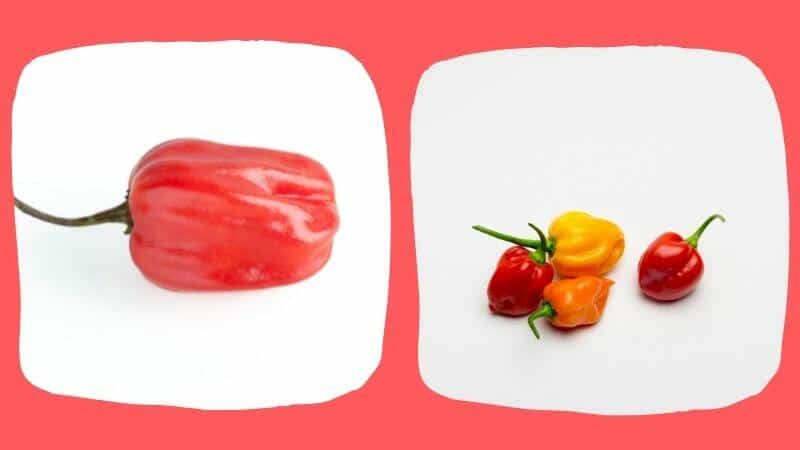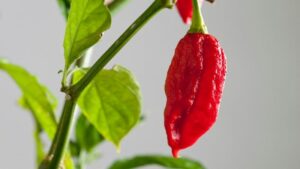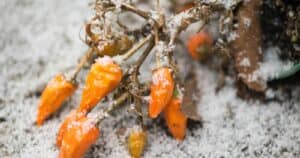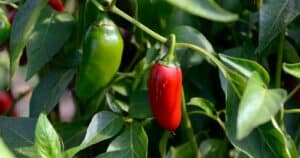If you love spicy cooking, you may wonder, “What’s the difference between scotch bonnet and habanero peppers?” While these two chili titans share a similarly searing heat range, they each bring their own unique zesty flavor.
Scotch bonnets lead with sweet, fruity notes before slamming you with intense
In this spicy showdown, you’ll discover:
- How scotch bonnets and habaneros differ in taste and scoville units
- Their origins and best uses in cuisine
- Growing and harvesting tips for both peppers
- How to substitute one for the other in recipes
Let the battle commence to see how these chili heavyweights stack up!
Scotch Bonnet vs Habanero: Heat and Flavor Profiles
While sharing a similar heat range, Scotch bonnets and habaneros each impart their own unique zing:
Scotch Bonnets
- Scoville Units: 100,000 to 350,000
- Flavor: Sweet and fruit-forward with intense, immediate heat
Habaneros
- Scoville Units: 100,000 to 350,000
- Flavor: Bittersweet and smoky, slow-building intense heat
So Scotch bonnets lead with sugary fruit flavors before slamming you with
Here’s a table that shows the differences between Scotch Bonnet and Habanero peppers.
| Features | Scotch Bonnet Pepper | Habanero |
|---|---|---|
| Shape | Rounder, firmer and larger | Slightly shorter and slimmer |
| Size | 1 to 2 ½ Inches | ¾ to 2 ½ Inches |
| Color | Light to dark orange – light to dark red | Green yellow, light – dark oranges, light – dark red. |
| Flavor | A bit sweet and fruity. Provides a spicy and strong kick almost immediately | Gradually increases in heat. Slightly sweet and fruity but bitter |
| Scoville Rating | 100,000-350,000 SHU | 100,000-350,000 SHU |
| Uses | Sauces, salsa, dressings | Sauces, salsa, dressings |
But Scoville ratings alone don’t tell the full tale…
What Impacts the Heat Level?
Several factors influence the pungency of these peppers beyond variety alone:
- Plant genetics – Some cultivars naturally produce more capsaicin
- Growing conditions – Stress increases spiciness
- Ripening stage – Fully ripe peppers pack more heat
- Processing – Drying concentrates spicy compounds
In short, an individual habanero could potentially out-burn a Scotch bonnet given certain circumstances. Time for a taste test!
Scotch Bonnet vs Habanero: Origins and Culinary Uses
Understanding the backgrounds of Scotch bonnets and habaneros gives insight into how best to use them:
Scotch Bonnets
- Originated in the Caribbean and West Indies
- Used in jerk dishes, stews, marinades, hot sauces
- Cuisines: Jamaican, Bahamian, Trinidadian
Habaneros
- Hail from the Amazon and Yucatan Peninsula
- Featured in salsa, moles, chili, Tex-Mex cuisine
- Iconic in Mexican and Southwestern cooking
When harnessing these peppers’ scorching heat, a little goes a long way. Add small amounts and adjust
How to Choose Fresh Scotch Bonnets and Habaneros
Follow these tips for picking peak fresh peppers:
- Seek glossy, firm skins without wrinkles
- Pick fully colored peppers for maximum ripeness
- Check that stems are intact – not dried out
- Aim for average size – 1 to 3 inches long
- Smell for aromatic, fruity scent
Top-quality fresh peppers ensure the best, most well-rounded chili flavor.
Growing Conditions for Scotch Bonnets vs Habaneros
Understanding ideal growing needs allows you to cultivate these peppers at home:
Scotch Bonnets
- Thrive in tropical, humid climates
- Extended summer heat speeds ripening
- Can be grown in pots moved indoors in winter
Habaneros
- Prefer hot, humid conditions
- Produce heaviest yields in zones 10-11
- Grow well containerized for moving into warmth
With the right care, you can successfully harvest bushels of these fiery peppers.
Storing Scotch Bonnet and Habanero Chilies
Follow these storage tips to extend shelf life:
- Refrigerate unwashed peppers in breathable bags for 2-3 weeks
- Freeze whole peppers in airtight containers for 4-6 months
- Pickle in jars submerged in brine for crunchy texture
- Dehydrate using a food dehydrator until crispy
Proper post-harvest storage lets you enjoy Scotch bonnet and habanero peppers year-round.
Using Habaneros and Scotch Bonnets in Your Cooking
When cooking with these ultra-spicy peppers:
- Add small amounts at first – heat levels vary
- Combine with sweet fruits and cooling dairy for balance
- Remove seeds and membranes to reduce burn
- Use pickled or ground dried versions to vary texture
- Substitute one pepper for the other based on flavor preferences
Now that you’re a Scotch bonnet vs habanero expert, let the flaming flavor fun begin!
The Takeaway
While Scotch bonnets and habaneros share similar heat ranges, they each contribute unique fruity, spicy flavors. Both pack a mighty punch, so adjust amounts accordingly.
Try using these chili heavyweights interchangeably depending on the dish and your heat tolerance. Just remember—you can always turn down the
FAQs: Scotch Bonnet vs Habanero
What are some good uses for Scotch bonnets?
Scotch bonnets shine in Caribbean jerk dishes, stews, marinades, and hot sauces. Their bright, tropical fruitiness balances rich meats and seafood.
Can you substitute Scotch bonnets for habaneros?
Yes, you can swap Scotch bonnets and habaneros in recipes, just adjust amounts based on your heat tolerance. Start with less and add more as desired.
Which pepper rates higher on the Scoville scale?
The two share a similar Scoville range, with individual peppers varying in heat based on growing conditions. Both can potentially reach 350,000 SHU at their upper limit.
What are the world’s hottest peppers?
The Carolina Reaper currently ranks #1 at over 2 million Scoville units! Other contenders include the Trinidad Moruga Scorpion, 7 Pot Douglah, and Naga Viper.





